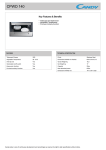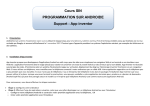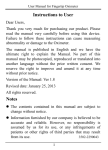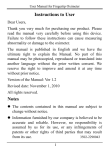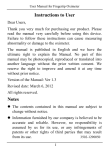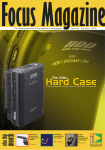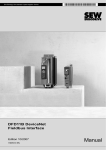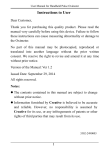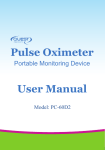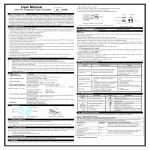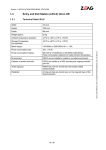Download User Manual
Transcript
I Fingertip Oximeter User Manual Shenzhen Creative Industry Co., Ltd. II Instructions to User Dear Customers, Thank you for purchasing this quality product. Please read the manual very carefully before using this device. Failure to follow these instructions can cause measuring abnormality or damage to the Oximeter. The manual is published in English and we have the ultimate right to explain the Manual. No part of this manual may be photocopied, reproduced or translated into another language without the prior written consent. We reserve the right to improve and amend it at any time without prior notice. Version of the Manual: Ver 1.4 Revised date: February 9th , 2015 All rights reserved. Notes z The contents contained in this manual are subject to change without notice. z Information furnished by our company is believed to be accurate and reliable. However, no responsibility is assumed by us for its use, or any infringements of patients or other rights of third parties that may result from its use. 3502-2290065 III Instructions for Safe Operation 0 Check the device to make sure that there is no visible damage that may affect user’s safety or measurement performance with regard to sensors and clips. It is recommended that the device should be inspected minimally before each use. If there is obvious damage, stop using the device. 0 Special attention should be paid while the oximeter is used constantly under the ambient temperature over 37°C, burning hurt may occur because of over-heating of the sensor at this situation. 0 Necessary maintenance must be performed only by qualified service technicians. Users are not permitted to service this device. 0 The Oximeter must not be used with devices and accessories not specified in User Manual. Cautions 0 Explosive hazard—DO NOT use the Oximeter in environment with inflammable gas such as some ignitable anesthetic agents. 0 DO NOT use the Oximeter while the patient is under MRI or CT scanning. This device is NOT MRI Compatible. IV Warnings 0 Discomfort or pain may appear if using the Oximeter continuously on the same location for a long time, especially for patient with poor microcirculation. It is recommended that the Oximeter should not be applied to the same location for longer than 2 hours. If any abnormal condition is found, please change the position of Oximeter. 0 DO NOT clip this device on edema or tender tissue. 0 The light (the infrared light is invisible) emitted from the device is harmful to the eyes. Do not stare at the light. The oximeter is not a treatment device. 0 0 Local laws and Regulations must be followed when disposing of the device. Attentions Keep the Oximeter away from dust, vibration, corrosive substances, explosive materials, high temperature and moisture. The device should be kept out of the reach of children. If the Oximeter gets wet, please stop using it and do not resume operation until it is dry and checked for correct operation. When it is carried from a cold V environment to a warm and humid environment, please do not use it immediately. Allow at least 15 minutes for Oximeter to reach ambient temperature. DO NOT operate the button on the front panel with sharp materials or sharp point. DO NOT use high temperature or high pressure steam disinfection on the Oximeter. Refer to Chapter 7 for instructions regarding cleaning and disinfection. Declaration of Conformity The manufacturer hereby declares that this device complies with the following standards: IEC 60601-1: 2005 Medical electrical equipment-Part 1: General requirements for basic safety and essential performance; BS/EN/ISO 9919:2009 or the equivalent ISO 80601-2-61:2011 - Medical electrical equipment -- Part 2-61: Particular requirements for basic safety and essential performance of pulse oximeter equipment. And it also follows the provisions of the council directive MDD 93/42/EEC. Caution: U.S. federal law restricts this device to sale or use by or on the order of a physician. VI FCC Rules are specifically for PC-60NW This device complies with Part 15 of the FCC Rules. Operation is subject to the following two conditions: (1) this device may not cause harmful interference, and (2) this device must accept any interference received, including interference that may cause undesired operation. Table of Contents 1 OVERVIEW.................................................................... 1 1.1 APPEARANCE...............................................................1 1.2 NAME AND MODEL.....................................................2 1.3 INTENDED USE............................................................2 1.4 FEATURE LIST.............................................................2 2 BATTERY INSTALLATION.........................................7 3 EXTERNAL SPO2 PROBE CONNECTION............... 8 4 OPERATION...................................................................9 5. TECHNICAL SPECIFICATIONS.............................18 6 REPAIR AND MAINTENANCE................................ 21 6.1 MAINTENANCE..........................................................21 6.2 CLEANING AND DISINFECTING INSTRUCTION........22 7 TROUBLESHOOTING................................................23 8 PACKING LIST............................................................23 9 KEY OF SYMBOLS.....................................................24 VII 1 Overview 1.1 Appearance Rubber Cushions Display Key Display Screen Figure 1 Front View Nameplate Battery Cover Lanyard Hole Figure 2 Rear View -1- 1.2 Name and Model Name: Fingertip Oximeter Model: POD-1a/POD-2a/POD-3a/POD-1/POD-2/POD3/PC-60A/POD-1W/PC-60B/PC-60B1/PC-60B 2/PC-60B3/ PC-60B5/PC-60C/PC-60C1/PC-60C2/ PC-60D/PC-60D2/PC-60E/PC-60N/PC-60NW 1.3 Intended Use This Fingertip Oximeter is intended for measuring the pulse rate and functional oxygen saturation (SpO2) through a patient’s finger. It is applicable for spot-checking SpO2 and pulse rate of adult and pediatric patients in homes and medical clinics. Models with external sensor options and over-limit Indication may be used for longer periods of time dependent on the suitability of the sensor selected. 1.4 Feature List Explanation of abbreviations: "√” this function is available, “-” without this function. Display type: X-Y-Z M=monochrome, D=dual color, C=full color L=LCD, O=OLED. S=segment, D=dot-matrix. Note: The finger clip of PC-60D & 60D2 are suitable for small fingers, especially for pediatric patients. The only -2- difference between these two oximeters is battery type. PC-60D installs rechargeable button cell battery which could use many times after being charged by the charger. Configuration of PC-XXXX Fingertip Oximeters Model Function Display type POD-1a POD-2a POD-3a POD-1 POD-2 POD-3 S-L-M S-L-D S-L-C S-L-M S-L-D S-L-C SpO2 √ √ √ √ √ √ PR √ √ √ √ √ √ PI (Perfusion index) - - - - - - Plethysmogram √ √ √ √ √ √ √ √ √ √ √ √ Low voltage indication Two directions display √ √ √ √ √ √ √ √ √ √ √ √ Wireless function - - - Option al - - Auto on Auto off -3- Model Function Display type 60A 60B 60B1 S-L-M S-L-M D-O-D 60B2 60B3 60B5 D-O-M D-O-D D-L-D SpO2 √ √ √ √ √ √ PR √ √ √ √ √ √ PI(Perfusion index) Plethysmogram - √ √ √ √ √ - - √ √ √ √ Auto on - √ √ √ √ √ Auto off √ √ √ √ √ √ Over-limit indication Low voltage indication Two directions display Waterproof & drop resistant Big numerical display - √ √ √ √ √ √ √ √ √ √ √ - - 4 √ 4 √ - - √ - - - - - - - - √ -4- Model Function Display type 60C 60C1 60C2 60D 60D2 60E D-O-C D-O-C D-O-C D-O-C D-O-C D-O-C SpO2, PR, PI √ √ √ √ √ √ Plethysmogram √ √ √ √ √ √ Auto on & off √ √ √ √ √ √ Over-limit indication Setting menu √ √ √ √ √ √ - √ - - - - Pulse beep - √ - - - √ Low voltage indication Four directions display Orientation-sensor √ √ √ √ √ √ √ √ √ √ √ √ - √ - - - √ External probe connection Big numerical display - - - - - √ √ √ - - - - -5- Model Function POD-1 W 60N Display type S-L-M D-OC D-OC D-OD S-L-M SpO2, PR, PI SpO2, PR, √ √ √ √ Plethysmogram - √ √ √ - Auto on √ √ √ √ - Auto off √ √ √ √ √ Setting menu - √ √ √ - Pulse beep - √ √ - - Low voltage indication Four directions display √ √ √ √ √ 2 √ √ √ - Orientationsensor - - √ - - External probe connection - √ √ - - Wireless function √ - √ √ √ -6- 60NW 60NW 60NW (Color) (Dual) (Monochrome) 2 Battery Installation Figure 3 Battery Installation 1. Refer to Figure 3, insert two AAA size batteries into the battery compartment properly, and note the polarity markings. 2. Replace the cover. • Please make sure that the batteries are correctly installed. Incorrect installation may cause the device not to work. • Please remove batteries if the device is not being used for more than 7 days to prevent and avoid potential damage from the battery leaking. Any such damage is not covered under the product warranty. -7- 3 External SpO2 Probe Connection Connect the external SpO2 probe to SpO2 sensor connector as shown below. Ensure the “Arrow” faces upwards. Figure 4 Probe Connection(For PC-60E, 60N, 60NW) Note: When the external SpO2 probe is connected, the built-in finger clip sensor will be disabled. The measurement is detected from the external SpO2 probe. Default over-limit indication settings for SpO2 and PR will change to: SpO2 Low limit: 95% Pulse Rate high limit: 160bpm Low limit: 60bpm -8- 4 Operation 1. Open the clip and put finger inside the rubber cushions of the clip (make sure the finger is in the correct position), and then clip the finger, as shown in figure 5. Figure 5 Put finger into the Oximeter 0 ① For PC-60A, press the display key to start the measurement. ② For other modules (except for PC-60A), wait 2 seconds, the oximeter will power on automatically and start to measure; 2. Next enter into data display screen: ① POD-1, POD-2 & POD-3 display screen are as shown in figure 6 Figure 6 Note: the display direction of POD-1a, POD-2a &POD-3a -9- is up and down. ② PC-60A & 60B display screen are as shown in figure 7A Figure 7A ③ For PC-60B, short time press Display Key to turn on/off the backlight. Longtime press Display Key to display PI as shown in figure 7B, after 8 seconds, the screen will return to the screen as shown in figure Figure 7B PI display screen(for PC-60B) 7A. ④ For other type oximeter PC-60B1, PC-60B2, PC-60B3, PC-60B5, PC-60C, PC-60C1, PC-60C2, PC-60D and PC-60D2, short time press Display Key to change display direction(Note: 60C1 changes direction automatically ) As shown in figure 8A& 8B; Longtime press Display Key to shift the parameter display between PR and PI. Please refer to figure 8C. -10- ⑤ For POD-1W, the display screen is as shown in figure 8G. Figure 8A Figure 8D Figure 8B Figure 8E Figure 8C Figure 8F Figure 8G Note: ¾ The PI% display will be shifted back to PR display automatically after 20 seconds even if no button operation. ¾ For the model PC-60B3, there is no plethysmogram display while the display direction is shifted to the right or left direction, as shown in figure 8D; To the opposite, PC-60B1 has no plethysmogram on default measuring screen as shown in figure 8E, while the display direction is shifted to left side direction, there will be displayed plethysmogram please refer to figure 8F. ¾ For the model of PC-60B2 & 60B5, only has two change directions: up and down. -11- ¾ The model PC-60B3 may have different options for manual switching display direction by button or automatic changing display direction by orientation sensor (similar to the model PC-60C1). ¾ For PC-60E, PC-60N and PC-60NW, when change display direction, PI value will automatically display on the device instead of PR value, PR value will restore after 20 seconds. ¾ For PC-60E, upward/downward shift the Oximeter quickly can turn on/off the pulse beep. The default pulse beep is OFF. ⑥ Menu (60C1, 60N, 60NW Dual & 60NWColor) PC-60 C1& 60N PC-60NW Dual PC-60NW Color Long time pressing display key could enter the setup menu screen. “Wireless”:the wireless on-off button. Transmitting data to PC when it is on. “on” and “off” can be optional. The factory default is “on”. “Pulse beep”:Pulse beep option. If it is set to on, every pulse beat makes a beep. Only for model PC-60NW, the pitch tone of this beep changes according to SpO2 value (within 90~99%). -12- Menu setup: Short time press Display Key to choose the setting item;Longtime press Display Key to active the setting item, then short time press it to modify the setting parameter; Next, longtime press Display Key to confirm the modification and exit from this setting item. At last, move the setting item to “Save, exit menu”, and long time pressing Display Key to store the modification and exit from the setup menu. Note: if wireless connection is setup, the icon " " will be displayed on the screen. 4.Wireless icon“ ”/" ": The icon “ ” of ” flashes “ blue “ ” long lights blue No display“ ” icon Definition The device is being to establish a wireless connection with the surrounding host. Successful wireless connection between the device and a host is established. 1."Wireless" function is disabled; 2. The device fails to setup a wireless connection with the surrounding host within 3 minutes; 3.Hardware failure of wireless transmission function while the -13- “Wireless” function is enabled. Wireless icon of POD-1W (the number of lines indicates signal intensity ) Data transmission The user could effectively transmit the data to computer through the wireless function. Refer to the “Oximeter Data Manager” for detailed information. Attention to the operation y The finger should be put into the sensor correctly. y Do not shake the finger and relax during measurement. y Do not put wet finger directly into sensor. y Avoid placing the device on the same limb which is wrapped with a cuff for blood pressure measurement or during venous infusion. y Do not let anything block the emitting light from device, i.e. do not use finger nail polish/paints. y Vigorous exercise and electrosurgical device interference may affect the measuring accuracy. y The orientation-sensor works on the basis of the gravity. A small movable metal ball is built in the orientation-sensor for detecting the orientation of the oximeter. When you want to change the oximeter’s display direction, if you move the Oximeter too slowly, the movable metal ball will also move slowly -14- because of not enough acceleration. Consequently the response of orientation detection would be delayed. Acceleration needs to be provided to the orientation-sensor for quick sensing the orientation change. y Nail polish may affect the measuring accuracy, and too long fingernail may cause failure of measurement or inaccurate result. y Existence of high intensive light sources, such as fluorescence light, ruby lamb, infrared heater or strong sunshine, etc. may cause inaccuracy of measurement result. Please put an opaque cover on the sensor or change the measuring site if necessary. y If the first reading appears with poor waveform (irregular or not smooth), then the reading is unlikely true, the more stable value is expected by waiting for a while, or a restart is needed when necessary. Note: Due to the working principle of orientation sensor used in the Oximeters, such as the model PC-60B3, there is a small metal ball which is movable within its compartment of the orientation-sensor. Therefore you may hear a slight “clatter” sound when you wave or shake the Oximeter, this is normal! -15- Downloading the APP software for Android smart phone The terminal devices such as Android smart phone can be used to receive data from the Oximeter in real-time, and store the received data, review the stored data as well. You have to download the corresponding APP software on the smart phone. Please follow the procedure to download: 1. Scan below QR code. 2. Open the link from the QR code. 3. Download the software “PC-60NW.apk” and install. 4. Run the software to connect the Oximeter for real-time data transfer. The below QR Code is appliable to the Fingertip Oximeter with wireless function. Instruction for Measurement ☞ Make sure the APP software is successful to connect with the Oximeter. ☞ Refer to the manual of this APP software for detail operation. Note: APP software for PC and Android smart phone is also available for download from below link: http://www.creative-sz.com/software/ NOTES: ① The two-dimensional barcode QR code shown in -16- Figure 9A is for Oximeter with bluetooth V2.x and Figure 9B is for Oximeter with bluetooth V4.0. That's to say, if your Oximeter is PC-60NW or PC-60B5, you need to scan at Figure 9A to download the corresponding APP software, while for POD-1W, you need to scan at Figure 9B. ② Please make sure the version of Android system for your smart phone should be V4.3 or higher, and include the bluetooth module of V4.0, otherwise, the downloaded APP software will not be compatible with the Oximeter. ③ Please make sure the APP software performs successful bluetooth connection with the Oximeter. Figure 9A Figure 9B (QR code for Oximeter (QR code for Oximeter with and bluetooth V2.0 ) with and bluetooth V4.0 ) -17- 5. Technical Specifications A. SpO2 Measurement Transducer: dual-wavelength LED sensor with wavelength: Red light: 663 nm, Infrared light: 890 nm. Maximal average optical output power: ≤1.5mW SpO2 measuring range: 35%~100% SpO2 measuring accuracy: ≤ 2% for SpO2 range from 70% to 100% B. Pulse Rate measurement PR measuring range: 30bpm~240bpm PR measuring accuracy: ±2bpm or ±2% (whichever is greater) C. Perfusion Index(PI) Display range 0%~20% D. Preset over-limits SpO2 low limit: 90% Pulse Rate: high limit: 120bpm low limit: 50bpm E. Over-limit indication settings for PC-60C1,N,NW: SpO2: low limit setting range: 85%~95% -18- Default setting: 85% Pulse Rate: Low limit setting range: 30~60bpm; High limit setting range: 100~240bpm; Default setting: high: 120bpm; low: 50bpm F. Over-limit settings for PC-60E SpO2: default low over-limit: For internal sensor: 90% For external sensor: 95% Pulse Rate: For internal sensor: High limit: 120bpm; Low limit: 50bpm For external sensor: High limit: 160bpm; Low limit: 60bpm G. Audible & visual alert function When measuring, if SpO2 value or pulse rate value exceeds the preset limit, the device will alert with beep automatically and the value which exceeds limit will flash on the screen. H. Power supply requirement: 2 x LR03 (AAA) alkaline batteries Supply voltage: 3.0VDC Operating current: ≤40mA -19- I. Environmental Conditions: Operating Temperature: Operating Humidity: Atmospheric pressure: 5°C ~40°C 30%~80% 70kPa~106kPa J. Low Perfusion Performance: The accuracy of SpO2 and PR measurement still meet the precision described above when the modulation amplitude is as low as 0.6%. K. Ambient Light Interference: The difference between the SpO2 value measured in the condition of indoor natural light and that of darkroom is less than ±1%. L. Dimensions: 66 mm (L) × 36 mm (W) × 33 mm (H) Net Weight: approx. 60g M. Classification The type of protection against electric shock: Internally powered equipment. The degree of protection against electric shock: Type BF applied parts. Electro-Magnetic Compatibility: Group I, Class B -20- 6 Repair and Maintenance 6.1 Maintenance The expected service life (not a warranty) of this device is 5 years. In order to ensure its long service life, please pay attention to the maintenance. y Please change the batteries when the low-voltage indicator lightens. y Please clean the surface of the device before using, with 75% alcohol wipes, then let it air dry or wipe it dry. Do not allow liquid to enter the device. y Please take out the batteries if the oximeter will not be used any more than 7 days. y The recommended storage environment of the device: ambient temperature: -20ºC ~60ºC, relative humidity 10%~95%, atmospheric pressure: 50kPa~107.4kPa. y The oximeter is calibrated in the factory before sale, so there is no need to calibrate it during its life cycle. Any SpO2 simulators should not be used to validate the accuracy of the oximeter, they can only be used as functional testers to verify its precision. The SpO2 accuracy claimed in this manual is supported by the clinical study conducted by inducing hypoxia on healthy, non-smoking, light-to-dark skinned subjects in an independent research laboratory. -21- y If it is necessary to verify the precision of the oximeter routinely, the user can do the verification by means of SpO2 simulator, or it can be done by the local third party test house. Please note that the specific calibration curve (so called R-curve) should be selected when use of SpO2 simulator, e.g. for Index 2 series SpO2 simulator from Fluke Biomedical Corporation, please set "Make" to "DownLoadMake: KRK", then the user can use this particular R-curve to test the oximeter. If the SpO2 simulator does not contain "KRK" R-curve, please ask the manufacturer for helping to download the given R-curve into the SpO2 simulator. High-pressure sterilization cannot be used on the device. Do not immerse the device in liquid. It is recommended that the device should be kept in a dry environment. Humidity may reduce the life of the device, or even damage it. 6.2 Cleaning and Disinfecting Instruction y Surface-clean sensor with a soft cloth damped with a solution such as 75% isopropyl alcohol, if low-level disinfection is required, use a mild bleach solution. y Then surface-clean with a cloth damped ONLY with clean water and dry with a clean, soft cloth. Caution: Do not sterilize by irradiation steam, or ethylene oxide. Do not use the Oximeter if it is damaged. -22- 7 Troubleshooting Problem: 1. The SpO2 and Pulse Rate display instable 2. Can not turn on the device 3. No display 4. Display direction doesn’t change or changes insensitively. 5. No display of the wireless icon “ ” Solution 1. Place the finger correctly inside and try again. 2. Let the patient keep calm. 3. Changing batteries 4. Please shake the oximeter with a certain force to make the movable metal ball move freely. If the problem still exists, maybe the orientation-sensor is not working properly. 5. Hardware failure of wireless transmission function. 6. If the above problem still exists please contact the local service center. 8 Packing List 1) Fingertip Oximeter 2) User Manual 3) Batteries 4) External SpO2 probe (Optional) Note: the items and its quantity are subject to change, please refer to your subject in hand. -23- 9 Key of Symbols Symbol Description Pulse oxygen saturation /PR PI% / / Pulse rate (beats per minute) Perfusion Index (%) Pulse Strength Bar Graph Low battery voltage CE mark Serial number Date of manufacture Authorised representative in the European community Manufacturer (including address) BF type applied part Attention ─ refer to User Manual Follow WEEE regulations for disposal Wireless icon -24- Shenzhen Creative Industry Co., Ltd. Tel: +86-755-2643 3514 Fax: +86-755-2643 0930 E-mail: [email protected] Website: www.creative-sz.com Address: 2/F, Block 3, Nanyou Tian'an Industry Town, 518054 Shenzhen, GD, P.R. China -25-
































